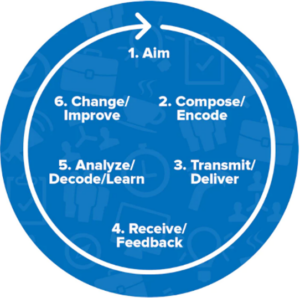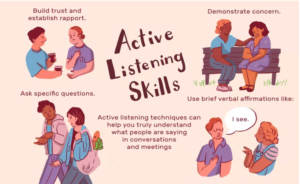At the end of this module, you will:
Why is effective communication so important?
We communicate every day, in more ways than one, and because of this it’s easy to assume we’re doing it well. The truth is that most of us are not as good at communication as we think we are.
Communication is vital to our survival. When effective, it gives us access to our needs or wants and strengthens relationships, enabling us to live enriched and purposeful lives. But all too often, when we try to communicate with others something goes astray. We say one thing, the other person hears something else, and misunderstandings, frustration, and conflicts ensue. This can cause problems in our home, school, and work relationships.
Whether you’re trying to improve communication with your partner, kids, boss, friends or colleagues, learning effective communication skills can deepen your connection to others, build greater trust and respect, and improve teamwork, problem solving, and your overall social and emotional health.
This module is all about helping you work towards better communication.
What does effective communication look like?
Effective communication is about more than just exchanging information, ideas, thoughts, opinions or knowledge. It’s about understanding the emotion and intentions behind the information. As well as being able to clearly convey a message, you need to listen in a way that gains the full meaning of what’s being said and makes the other person feel heard and understood.
We communicate in many different ways (verbal and non-verbal, written, visual, and listening) using a range of mediums such as in person, on the internet (on forums, social media, and websites), over the phone (through apps, calls, and video), or by mail. Because of this, it makes sense that learning how to communicate effectively takes time and practice.
Communication cycle
Every time we communicate there are essentially two roles – sender (person communicating a message) and receiver (person hearing a message). When we communicate effectively, both the sender and receiver have acquired the skills to play their role successfully. The word choice, facial expressions, tone of voice, eye contact and body language, as well as gestures, signals and visuals are all mastered.
To understand how interconnected the sender and receiver roles are in achieving effective communication, we can look at communication as a cycle. The below image explains the steps we all take (sometimes consciously, other times unconsciously) to develop and deliver a message, and receive feedback from the person we are communicating with.


Did you know?
Nonverbal aspects of communication make up to 93% of the components of the communication process, whereas words make up 7%. The ability to interpret facial expressions, tone and pitch of voice, body posture and gestures is a far greater skill than the choice of words when feelings or attitudes are involved.
ACTIVITY: Dive Deeper
If you’d like to know more about the Communication Cycle and how it might apply as an example, visit www.mindtools.com/af8d7mc/the-communication-cycle. Give the steps a go next time you have an important message you want to communicate with someone.
The 7c’s of effective communication
Have you ever had to re-read a text message or email because it seemed to go around in circles and by the end of it, you weren’t sure what it meant? Or maybe you’ve listened to someone talk for five minutes and when it’s time to respond you’re confused because too much was said at once?
If you’re crafting a message to send to someone, the seven Cs are something you want to keep in mind to make sure you’re communicating effectively:

EXAMPLE: John asks his manager to be clearer on priorities
Hi Sally. I wanted to seek clarity on which tasks are priority. Attached is my current list of tasks over the next few months. I have attempted to order them, but as new projects are arising frequently, it has become unclear which is most important, as well as their deadlines. Could you please order the spreadsheet, or if you have time and would prefer, book in a meeting to work through this with me? Thanks. John.
The 7c’s of effective communication
As you’ve probably learnt by now, communication is about more than words. Active listening plays a key role in two-way communication and is especially important for the receiver.
Listening actively means fully concentrating on the other person, trying to understand both the words being said and the emotion behind them, as well as responding appropriately. It’s a skill!
But don’t sweat, it’s a skill that can be learnt. We’ve included the components of active listening and some examples below to help you out.

Building trust and establishing rapport: “Tell me what I can do to help.” “I was really impressed to read on your website how you donate 5% of each sale to charity.”
Demonstrating concern: “I’m eager to help; I know you’re going through some tough challenges.” “I know how hard a corporate restructuring can be. How is staff morale at this point?”
Paraphrasing: “So, you’re saying that the uncertainty about who your new supervisor will be is creating stress for you.” “So, you feel like you’re taking on too much at the moment and need more support at home?”
Brief verbal affirmation: “Thank you for sharing with me, I know how difficult it can be.”
“I understand that you’d like more frequent feedback about your performance.”
Asking open-ended questions: “I can see that John’s criticism was very upsetting to you. Which aspect of his critique was most disturbing?” “It’s clear that the current situation is intolerable for you. What changes would you like to see?”
Asking specific questions: “How long do you expect your hiring process to last?” “What did she say to you that upset you?”
Waiting to disclose your opinion: “Tell me more about your proposal to reorganise the department.” “Can you share a little more about what’s been going on in your mind?”
Disclosing similar situations: “I was also conflicted about returning to work after the birth of my son.” “I know when I have too much on my plate, my brain turns to mush and I struggle to organise my thoughts and tasks.”
What stops us from communicating effectively?
Obviously we can’t communicate perfectly all the time, and certain barriers will get in the way. It’s helpful to be aware of these so you can either a) try and eliminate them or b) manage them.
Stress
When you’re stressed or emotionally overwhelmed, you’re more likely to misread other people, send confusing or off-putting nonverbal signals, and lapse into unhealthy knee-jerk patterns of behaviour. To avoid conflict and misunderstandings, it might be helpful to pause before responding or practice de-escalation techniques.
Lack of focus
There’s nothing worse than talking to someone and knowing their mind is elsewhere. It’s impossible to communicate effectively when you’re multitasking. If you’re checking your phone, on your computer, thinking about what you’re going to say next, or off with the fairies, you’ll miss key words and nonverbal cues in the conversation. To communicate effectively, you need to avoid distractions and stay focused.
Language
Speaking different languages is a huge barrier to communicating effectively – there’s only so much we can get across through gestures and signals. Additionally, not everyone has the same vocabulary – think about how you communicate with your child as opposed to your colleague. We need to tailor our language to suit the person we are communicating with.
Distance
The saying absence makes the heart grow fonder isn’t always true! When communicating with someone who lives in another state or country (think remote working, long distance relationships etc), a conscious effort is required to maintain deep connections. That’s where things like facetime are great because they allow us to see facial expressions and some body language, rather than making assumptions.
Body Language
If you disagree with or dislike what’s being said, you might use negative body language to reject the other person’s message, such as crossing your arms, avoiding eye contact, or tapping your feet. You don’t have to agree with, or even like what’s being said, but to communicate effectively and not put the other person on the defensive, it’s important to avoid sending negative signals.
What are the benefits of communicating effectively?
The benefits of effective communication skills will spread into every aspect of your life; home, work, education, intimate relationships and friendships. But to delve a little deeper, below are some benefits in two key areas – personal and professional settings.
| In the workplace, effective communication can help you: | In your personal life, effective communication can help you: |
|---|---|
| Build strong working relationships and attract more opportunities for you or your organisation. | Deepen existing connections |
| Raise issues in a constructive way. | Create new bonds based on trust and transparency. |
| Manage employees and build teams. | Problem solve and resolve conflict. |
| Retain employees and increase employee satisfaction. | Be socially, emotionally and mentally healthy. |
TIPS: How to measure your communication style
Do you know your communication style? Do we want an unbiased opinion on how well you communicate?
Rather than jumping straight to strategies for better communication, it’s useful to have a baseline understanding of your personal strengths, preferred approach and areas for improvement. Dr Jon Warner developed The Communication Effectiveness Profile which explores and assesses seven areas of effective communication specific to you.
Rather than jumping straight to strategies for better communication, it’s useful to have a baseline understanding of your personal strengths, preferred approach and areas for improvement. Dr Jon Warner developed The Communication Effectiveness Profile which explores and assesses seven areas of effective communication specific to you.
- Empathising: the extent to which you think about the perspectives and feelings of others when they are communicating with you, and the degree to which you adjust your style to accommodate them.
- Receiving the Message: how well you listen to and successfully “process” what others are saying (verbal and non-verbal messages) before you respond.
- Clarifying: the extent to which you use careful and incisive questioning techniques to successfully “translate” the words and actions of the other party in order to understand their meaning.
- Understanding: the extent to which you make sense of what you see and hear in order to engage fully in a conversation and respond intelligently, according to the circumstances.
- “Reading” Non-Verbal Clues: how well you pick up on body language and tone of voice in order to understand the complete communication message.
- Giving and Receiving Feedback: whether you’re able to successfully offer constructive feedback to others and accept direct feedback from others.
- Transmitting Your Message: the extent to which you use a range of communication methods and means to get your message across to others successfully.
ACTIVITY: Measure your communication skills
Complete the Communication Effectiveness questionnaire to understand your strengths and weaknesses, as well as get tips on how to improve: www3.hrdpress.com/files/product_pdfs/Competency_Profiles/COMEP.pdf. Bring the results to your next session with a clinician to talk through.
TIPS: Strategies for improving your communication
You’ev probably already found some hidden tips throughout the module (such as the 7 Cs and active listening prompts), but one of the best ways to improve your communication is to focus on two key things: empathy and self-awareness.
Empathy is the ability to understand and experience someone else’s feelings and to adopt their viewpoint.
Self-awareness involves being able to see yourself clearly and objectively through reflection and introspection. The more aware you are of your own patterns of behaviour, the better equipped you are to interact, engage and communicate with others in ways that promote positive wellbeing and outstanding productivity.
A useful way to gain a deep level of self awareness is to seek feedback from others. When you have objective information about how you project your values, beliefs, intentions or emotions out to others, you can compare this with your own understanding. If there are significant discrepancies, you’ll know where to focus your efforts to improve.
As you go through your day, observe your own patterns of communication.
- How do you position yourself when speaking to people?
- Does it change based on who you are talking to?
- How do people react to you?
Observe the behaviours of others:
- Are there certain people who make you feel heard?
- What do they do that makes you feel like that?
- Is there someone who is unpleasant to communicate with? Why? What actions do they do that make you not enjoy talking to them?
But wait, there’s more:
Below are some other proven strategies to improve your written and verbal communication.
- Paraphrase: repeat what you heard in your own words, to show that you understand, and ask if you missed anything. You can always end with the question, “Did I get that correct?”
- Give your full attention: turn off your phone/ put it to the side, turn away from your computer, make consistent eye contact and avoid fidgeting.
- Be confident in your use of space: don’t minimise yourself, instead relax into your space.
- Pause: if you feel yourself getting emotional or combative, pause and take a breath before responding.
- Before you speak, know what you want to communicate: follow the formula for all communications, informal and formal.
- Begin with your purpose ie; I think we need to increase ad spending by 10%
- Move on to your reasoning ie; The upcoming holiday period is prime time to target our customers more effectively
- Review outcomes ie; we could increase sales by 20-30%
- Take the time to re-read everything that you write: Is your tone appropriate for the setting? Are there any spelling mistakes, grammatical errors, items not linked properly, or missing points? Is it formatted to enhance readership? Have you covered the subject in enough depth?
Key Takeaways
Resources and Further Reading
Below are some useful resources (some mentioned throughout this module) to help monitor and manage stress.
- Communication Effectiveness questionnaire: hrdpress.com/files/product_pdfs/Competency_Profiles/COMEP.pdf
- The Communication Cycle: mindtools.com/af8d7mc/the-communication-cycleBelow are some useful resources (some mentioned throughout this module) to help monitor and manage stress.
- Active Listening worksheet: https://positivepsychology.com/how-to-improve-communication-skills/#worksheets
If you would like to know more about habits, below are some recommended articles. Some of these may be quite technical, so if you have any questions, be sure to write them down and bring them to your next session.
| The (over)use of SMART goals for physical activity promotion: A narrative review and critique
2022. Health Psychology Review. |
|
| A meta-analysis of techniques to promote motivation for health behaviour change from a self-determination theory perspective
2019. Health Psychology Review. |
|
| Do we need to reconsider best practice in goal setting for physical activity promotion?
2018. British Journal of Sports Medicine. |
|
| Healthy through habit: Interventions for initiating & maintaining health behavior change.
2016. Behavioural Science & Policy. |
Below are some recommended articles and videos. If you have any questions, be sure to write them down and bring them to your next session.
 |
Chris Lee – Art of Listening
Lewis Howes Podcast |
 |
How to improve communication skills
2022. Andreev, I. |
 |
14 Best Worksheets to improve communication skills 2021. Celestine, N. |
 |
A people leader’s guide to active listening
2019. Wermuth, M. |
